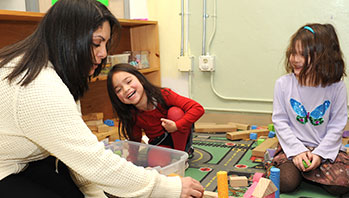MA Standards:
English Language Arts/Speaking and Listening/SL.PK.MA.1a Observe and use appropriate ways of interacting in a group (e.g., taking turns in talking, listening to peers, waiting to speak until another person is finished talking, asking questions and waiting for an answer, gaining the floor in appropriate ways).
English Language Arts/Foundational Skills/RF.PK.MA.2.c Identify the initial sound of a spoken word and, with guidance and support, generate several other words that have the same initial sound.
Head Start Outcomes:
Social Emotional Development/Self-Regulation Follows simple rules, routines, and directions.
Literacy Knowledge/Phonological Awareness Identifies and discriminates between sounds and phonemes in language, such as attention to beginning and ending sounds of words and recognition that different words begin or end with the same sound.
PreK Learning Guidelines:
English Language Arts/Language 1 Observe and use appropriate ways of interacting in a group (taking turns in talking; listening to peers; waiting until someone is finished; asking questions and waiting for an answer; gaining the floor in appropriate ways).
English Language Arts/Reading and Literature 12 Listen to, recite, sing, and dramatize a variety of age-appropriate literature.
English Language Arts/Reading and Literature 8 Listen to, identify, and manipulate language sounds to develop auditory discrimination and phonemic awareness.
EEC
PW50. The older toddler engages in a variety of physical activities.
Play Together: Samantha Says (“Hh”)

© Commonwealth of Massachusetts, Department of Early Education and Care (Jennifer Waddell photographer). All rights reserved.
ELA Focus Skills: Follow Directions, Gross Motor Skills, Phonological Awareness (Beginning Sounds)
Tell children you are going to play a game called “Samantha Says.” First have children repeat some /h/ words after you. Say, Repeat the following /h/ words after me and stretch out the /h/ sound, like this, h-h-h-hair. Continue with h-h-h-hill, h-h-h-head, h-h-h-hips, h-h-h-hop, h-h-h-hug, h-h-h-hum.
Then explain that when you say a word that begins with the /h/ sound, you want children to do what Samantha says. Say, But if I say a word that begins with a different sound, then you stand still. Demonstrate with the words head and foot.
Say, Samantha says touch your h-h-h-head. Emphasize the /h/ sound in the word head. Tell children to touch their heads. Then say: Samantha says tap your foot.
- Repeat with the words hair, nose, hand, toes, hips, and ears.
English Language Learners: If children have difficulty pronouncing the /h/, have them put their hand in front of their mouth and breath out to feel the air. Tell children to leave their hand there as they say some /h/ words because you want them to feel the air on their hand. Then have them exaggerate the /h/ in the word h-h-h-hill as they continue to feel the air. Repeat with other words.
